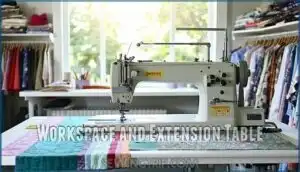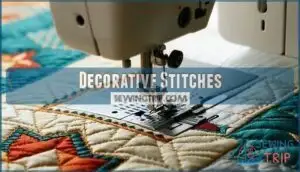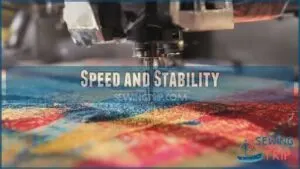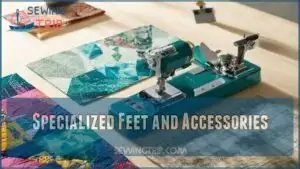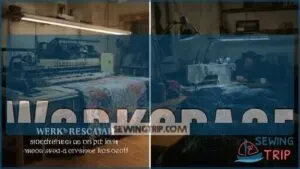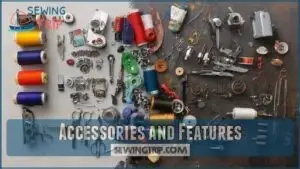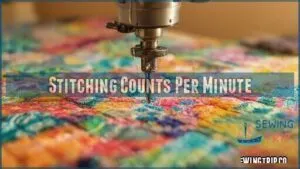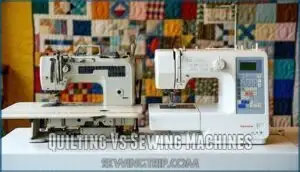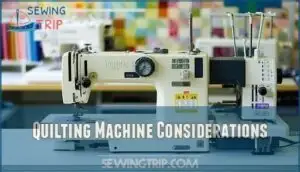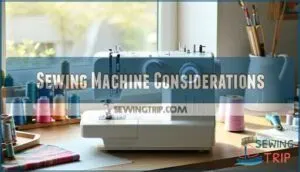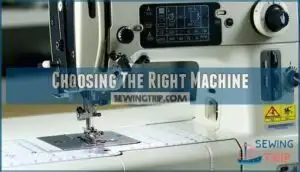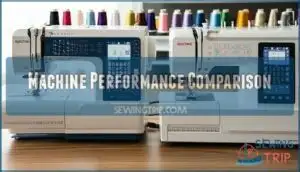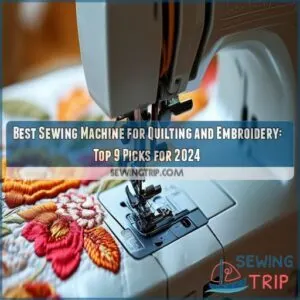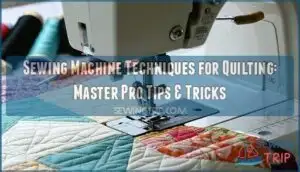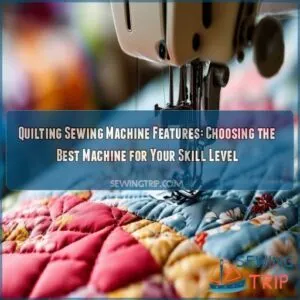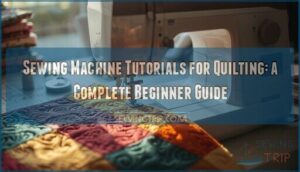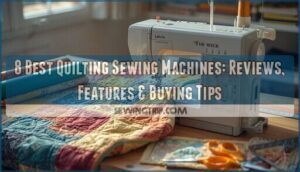This site is supported by our readers. We may earn a commission, at no cost to you, if you purchase through links.
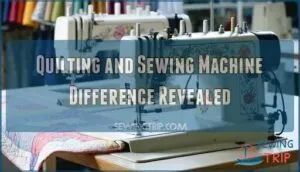 You’re wondering about the quilting and sewing machine difference.
You’re wondering about the quilting and sewing machine difference.
Basically, quilting machines have a larger "throat" space, allowing for bigger projects, and often come with specialized feet and decorative stitches.
They’re usually more expensive than sewing machines.
As you explore the quilting and sewing machine difference, you’ll find that each has its own strengths and weaknesses, and understanding these will help you choose the right machine for your needs, and that’s just the beginning of uncovering the unique features and capabilities of each.
Table Of Contents
Key Takeaways
- You’ll need more workspace for quilting – Quilting machines offer 9+ inch throat space and extension tables, while sewing machines typically have 4-6 inch throats that limit your ability to handle large quilt projects comfortably.
- Speed and stability matter for different tasks – Quilting machines reach up to 1,600 stitches per minute with vibration reduction features, making them ideal for large projects, while sewing machines operate at moderate speeds (850-1,100 SPM) that work fine for garments and smaller items.
- Your budget and space requirements differ significantly – Quilting machines cost more and need dedicated workspace or rooms, while sewing machines fit tight spaces and offer budget-friendly entry points under $500.
- You can quilt on a regular sewing machine, but it’s limiting – While sewing machines can handle basic quilting tasks, they struggle with thick, bulky quilts and lack specialized feet like quarter-inch piecing feet and free-motion capabilities that make quilting easier.
Quilting Machine Features
You’ll find that quilting machines have distinct features that set them apart from regular sewing machines.
Quilting machines offer unique features for large projects and complex designs.
As you explore quilting machine features, you’ll notice they often include a wider workspace, specialized feet, and higher speeds, making them ideal for handling large, bulky quilt projects.
Workspace and Extension Table
You’ll notice a quilting machine has a larger throat size, ideal for bulky projects.
Key benefits include:
- Larger workspace
- Extension table benefits
- Improved ergonomics
- Reduced machine footprint
- Enhanced quilting experience
Many quilters also enhance their quilting machine setup for an improved efficiency and overall quilting experience.
Decorative Stitches
You’ll explore decorative stitches on quilting machines, like zigzag and satin stitches, which add style to quilt borders.
For best results with these stitches, consider using an open toe embroidery foot.
| Stitch Type | Description |
|---|---|
| Zigzag | Basic decorative stitch |
| Satin | Dense stitches for patterns |
Speed and Stability
You’ll find quilting machines offer several speed advantages, including:
- Higher SPM
- Vibration reduction
- Better fabric handling
- Stronger motor strength, ensuring consistent stitching at high speeds, a key difference between quilting and sewing machines.
Many users appreciate the improved efficiency offered by these machines.
Specialized Feet and Accessories
You’ll use specialized feet like the Piecing Foot and Free-Motion Foot on your quilting machine.
The AcuFeed System, Walking Foot, and Open-Toe Foot enhance precision, making quilting vs sewing machine choices clearer, especially with the quarterinch foot and darning foot options available for quilting machines.
Quilting, unlike sewing, involves layering three fabrics for warmth and design, and utilizes specific techniques that differentiate it from regular sewing, highlighting the importance of the right tools.
Sewing Machine Features
You’ll find that sewing machines have distinct features, such as smaller workspaces and lower stitching speeds, that set them apart from quilting machines.
As you explore sewing machine features, you’ll notice they’re designed for general sewing tasks, with accessories and stitching counts per minute that differ from those of quilting machines.
Workspace
Unlike a quilting machine, a sewing machine offers a different workspace experience.
You’ll find it’s smaller, but still useful for many projects.
Consider these points:
- Smaller throat size
- Limited space for bulky projects
- Workspace ergonomics for smaller items
- Compact machine footprint
Extension tables aren’t usually included, so managing large quilts can be tough.
The throat space is less than a quilting machine, impacting what you can create, with a smaller throat size and limited space for bulky projects, affecting workspace ergonomics.
Accessories and Features
Sewing machines come packed with versatile accessories that’ll make your head spin.
You’ll find buttonhole feet, zipper feet, and walking feet that handle everything from delicate hemming to heavy-duty construction.
Many sewers find that they need specialized sewing accessories for best results.
Unlike quilting machine accessories focused on specialized feet and stitch regulation, sewing machine features emphasize broad functionality for countless projects beyond quilting, including those that require heavy-duty construction.
Stitching Counts Per Minute
Regular sewing machines typically operate at moderate speeds, usually ranging from 850 to 1,100 stitches per minute.
While they can’t match quilting machine speeds, they’re perfectly adequate for most home sewing projects. One key aspect of sewing is the foot pedal control, which allows for variable speed.
Here’s what SPM Impact means for your sewing experience:
- Speed Durability – Higher SPM machines often feature stronger motors that last longer
- Project Completion – Faster stitching means you’ll finish garments and home décor items quicker
- Stitch Consistency – Quality machines maintain even stitches regardless of speed settings
- Quilting Speed – Some high-end sewing machines can handle light quilting at decent speeds
- Machine longevity – Well-built motors handle variable speeds without premature wear
Quilting Vs Sewing Machines
You’re probably wondering whether you need a quilting machine or if your regular sewing machine will handle those ambitious quilt projects.
The truth is, these machines are built for different purposes, and understanding their key differences will save you time, frustration, and potentially money, which is a crucial consideration for ambitious quilt projects.
Key Differences
Workspace Size distinguishes these machines dramatically. Your quilting machine offers expansive throat space and extension tables, while sewing machines provide compact workspaces suitable for garment construction.
Speed Capabilities vary substantially—quilting machines reach 1,600 SPM with enhanced stability features.
| Feature | Quilting Machine | Sewing Machine |
|---|---|---|
| Workspace Size | 9"+ throat, extension tables | 4-6" throat, compact design |
| Speed Capabilities | Up to 1,600 SPM | Lower SPM ratings |
| Foot Attachments | Free-motion, quarter-inch, walking feet | Basic utility feet |
The key differences between quilting and sewing machines are highlighted in their Speed Capabilities and workspace sizes, making each suitable for different types of projects, with quilting machines offering more expansive throat space for larger quilts.
Similarities and Overlaps
Both machine types share essential Shared Functionality for Basic Stitching and Repair Capabilities.
You’ll find overlapping features that make Beginner Projects and Home Decor accessible on either machine.
| Feature | Shared Capability |
|---|---|
| Basic straight stitch | Standard on both types |
| Zigzag patterns | Common stitching option |
| Buttonhole creation | Available across models |
| Fabric feeding system | Feed dogs move material |
Machine differences blur when examining core sewing machine features versus quilting machine features.
Machine capabilities often overlap more than the quilting vs sewing debate suggests.
Quilting Machine Considerations
Before investing in a quilting machine, you’ll need to weigh several practical factors that can make or break your sewing experience.
Weigh practical factors before investing in a quilting machine
The cost, space requirements, and learning curve are significant considerations that differ greatly from standard sewing machines, and understanding these practical factors is crucial for a smooth sewing experience.
Cost and Space
When thinking about quilting vs sewing, the initial investment and long-term costs really jump out.
Quilting machines often mean a bigger price tag and bigger space requirements—expect a dedicated corner or room.
Standard sewing machines, by contrast, squeeze into tight spots and offer smart storage solutions.
Balance your budget prioritization and workspace needs when weighing space consideration for both types.
Entry-level options impact sewing machine cost and are often under $500, which can be a significant factor in long-term costs and overall budget prioritization.
Mastery and Variation
Space issues aside, the real adventure begins as you build skill and experiment.
With quilting machines, expect more technique exploration, creative adaptations, and plenty of mastery over complex designs.
You’ll notice stark quilting differences and sewing differences as you level up—each project opens new doors to quilting variation, sewing variation, and true machine versatility.
- Skill development challenges
- Technique exploration excitement
- Creative adaptations you’ll love
- Tackling project complexity
Selection and Quality
If you’re looking to master quilting or sewing, focus on how you pick your gear.
Strong Brand Reputation, solid Build Quality, and Material Durability should top your list.
Stitch Consistency and Feature Reliability separate a great quilting machine from a regular sewing machine.
Each is built for different jobs, so compare the differences in purpose before choosing, considering Stitch Consistency.
Sewing Machine Considerations
When you’re looking at sewing machines, you’ll want to think about their available accessories and how easy they’re to move or store.
These machines work best for basic sewing projects, offering enough workspace and straightforward features for home use.
Accessories
Choosing sewing accessories can be like picking spices for a recipe—get the right mix for best results.
You’ll find a range of presser feet, from Specialized Feet for zippers to the handy AcuFeed System borrowed from quilting machines.
Exploring different options can enhance your sewing capabilities, especially when considering specialized sewing feet.
Optional accessories boost Fabric Control and Stitch Visibility, so your sewing machine matches the versatility of any quilting machine or dedicated quilting accessories.
Portability and Convenience
Anyone who’s ever tried to drag a quilting machine across the house knows it’s like moving a small appliance.
In the context of Travel Sewing, you want portability.
Here’s why sewing machines win:
- Lightweight for easy transport
- Compact models fit tight spaces
- Simple storage options
- Smaller workspace size
- Ideal for travel size needs
Choosing The Right Machine
When you’re choosing between a quilting machine and a regular sewing machine, you’ll want to think about exactly what projects you plan to tackle and how much space you have for your setup.
It’s important to compare brands, check model features, and consider your budget, because picking the right machine makes finishing your projects a lot easier.
Determining Intended Use
You’re considering a quilting or sewing machine.
Determining intended use is key.
Think about project size, fabric types, and skill level to decide between a quilting machine for large, complex projects or a sewing machine for smaller tasks, factoring in budget allocation for your quilting or sewing needs.
Researching Models and Brands
You research models and brands, weighing factors like
- Brand reputation
- Model comparisons
- Feature availability
- Budget options
- Warranty coverage for your quilting or sewing machine.
Considering quilting brands like Juki and sewing brands like Brother is part of this research, focusing on complete concepts that meet your needs.
Budget and Space Consideration
You weigh budget and space consideration.
| Initial investment | Long-term costs | Space requirements |
|---|---|---|
| High | Low | Large |
| Medium | Medium | Medium |
| Low | High | Small |
Consider machine portability and storage solutions for affordability and price.
Machine Performance Comparison
You’ll compare the performance of quilting and sewing machines, focusing on stitch quality and customization options.
By examining these key aspects, you’ll understand the differences between these machines and make an informed decision for your needs, considering complete concepts.
Stitch Quality and Consistency
You’ll notice a quilting machine offers better stitch quality and consistency due to advanced features like tension control and stitch regulation.
| Needle Types | Fabric Feeding | Thread Quality |
|---|---|---|
| Sharp | Automatic | Cotton |
| Blunt | Manual | Polyester |
| Universal | Assisted | Blend |
The table outlines various options for needle types, fabric feeding mechanisms, and thread quality, which are essential considerations for quilting projects.
Versatility and Customization Options
You compare quilting and sewing machines.
| Quilting Features | Sewing Features | Machine Type |
|---|---|---|
| Stitch Programming | Decorative Stitches | Quilting Machine |
| Software Integration | User Interface | Sewing Machine |
| Creative Add-ons | Personalized Settings | Hybrid Machine |
Many users find that automatic needle threaders simplify the sewing process with the help of automatic needle threaders.
Frequently Asked Questions (FAQs)
Is a quilting machine different from a sewing machine?
You’ll find that quilting machines have larger workspaces and specialized features, making them distinct from regular sewing machines regarding functionality and design.
Can a regular sewing machine do quilting?
You can use a regular sewing machine for quilting, but it may not handle large or thick quilts as smoothly as a dedicated quilting machine.
Is quilting and sewing the same thing?
Like comparing a paintbrush to an entire art studio, quilting and sewing aren’t the same thing.
Quilting’s a specialized technique within sewing that joins three layers together, while sewing encompasses all fabric stitching methods.
What is special about a quilting machine?
Quilting machines feature wider throat spaces, specialized feet for precise quarter-inch seams, higher speeds up to 1,600 stitches per minute, and extension tables for handling bulky multi-layer projects efficiently.
What is maintenance for quilting machines?
An ounce of prevention’s worth a pound of cure—you’ll need regular cleaning, oiling, tension adjustments, needle replacements, and professional servicing to keep your quilting machine running smoothly.
Can sewing machines be upgraded easily?
You can upgrade some features on basic sewing machines, but it’s limited.
Most upgrades involve changing presser feet, adding accessories, or installing new stitches.
However, you can’t upgrade major components like motors or computerized features.
How to store quilting machines safely?
Store your quilting machine in a clean, dry room with stable temperature. Cover it with a dust cover, remove the needle, and keep it away from direct sunlight and moisture.
Are quilting machines good for beginners?
Can you truly master quilting without the right foundation?
You’ll find quilting machines challenging as a beginner due to their complexity, specialized features, and higher speeds that require experience to control effectively.
This challenge is compounded by the fact that these machines have many specialized features.
What is warranty on quilting machines?
Quilting machine warranties typically last 1-3 years, covering defects and mechanical issues.
You’ll find longer coverage on higher-end models, while budget machines offer shorter terms.
Always register your machine promptly for full warranty protection.
Conclusion
Before Instagram influencers started posting their latest quilting projects, crafters had to rely on choosing the right machine for their needs.
Understanding the quilting and sewing machine difference helps you make smart decisions. You’ve learned that quilting machines offer larger throat space and specialized features, while sewing machines provide versatility and portability.
Consider your projects, budget, and available space when deciding. Both machines have their place in creative work, so choose based on what you’ll actually use most often.
- https://machine.goldsupplier.com/blog/embroidery-and-quilting-machine/
- https://www.iis-servo.com/applications/single-needle-panel-quilting-machine/
- https://quiltingwithmachines.com/about-quilting-with-machines/
- https://www.kenssewingcenter.com/sewing-machines/janome-sewing-machines/janome-quilting-machines.html
- https://www.mybluprint.com/article/free-motion-quilting-foot

